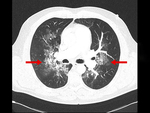Learning objectives
Learning objectives
To understand the pathophysiology of high-altitude pulmonary edema
To illustrate typical radiological findings
To describe important differential diagnoses
Background
Background
High altitude pulmonal edema (HAPE) is an acute noncardiogenic pulmonary edema caused by patchy hypoxic pulmonary vasoconstriction [1,2]. Typically, this form of pulmonary edema is seen in people who travel from lower elevation to high elevation (>2500 m) and is related to altitude and rate of ascent [3,4,5]. HAPE mainly occurs due to exaggerated hypoxic pulmonary vasoconstriction and elevated pulmonary artery pressure (Fig.1). The estimated incidence in high altitude in our region is about 0.05-0.1%. High altitude pulmonary edema must be considered in acute...
Findings and procedure details
Findings and procedure details
Differentiating HAPE from pneumonia or heart failure can be difficult. Rapid response to oxygen therapy strongly suggests the diagnosis of high-altitude pulmonary edema. Very difficult to diagnose is HAPE with concomitant pneumonia.
Imaging of HAPE
Imaging findings in high altitude pulmonary edema are bilateral multiple prevalent perihilar sided vascular opacities in the lung parenchyma at chest radiograph (Fig 2).
On CT we can see bilateral multiple peribroncovascular parenchymal consolidations, partially confluent (Fig.3 and Fig.4). Pneumonia can have extensive infiltrates on chest...
Conclusion
Conclusion
High altitude pulmonal edema (HAPE) is an acute noncardiogenic pulmonary edema caused by patchy hypoxic pulmonary vasoconstriction and have to be considered in acute care centers in regions with high mountains. This form of pulmonary edema is seen in people who travel from lower elevation to high elevation (>2500 m) and is related to altitude and rate of ascent.
HAPE mainly occurs due to exaggerated hypoxic pulmonary vasoconstriction and elevated pulmonary artery pressure. This kind of edema causes a form of consolidation which tends...
Personal information and conflict of interest
S. Stuppner; Bozen/IT - nothing to disclose A. Ruiu; Bozen/IT - nothing to disclose
References
References
[1] B.B. Das, R.R. Wolfe, K.C. Chan, G.L. Larsen, J.T. Reeves, D. Ivy
High-altitude pulmonary edema in children with underlying cardiopulmonary disorders and pulmonary hypertension living at altitude Arch Pediatr Adolesc Med, 158 (2004), pp. 1170-1176. PMID: 15583103 DOI: 10.1001/archpedi.158.12.1170
[2] E.R. Swenson, P. Bartsch. High-altitude pulmonary edema. Compr Physiol,2 (2012), pp. 2753-2773. PMID:23720264 DOI: 10.1002/cphy.c100029
[3] P. Bartsch, E.R. Swenson Acute high-altitude illnesses
N Engl J Med, 369 (2013), pp. 1666-1667. PMID: 24152275
DOI:10.1056/NEJMc1309747
[4] High-altitude pulmonary edema at a ski resort. H...





